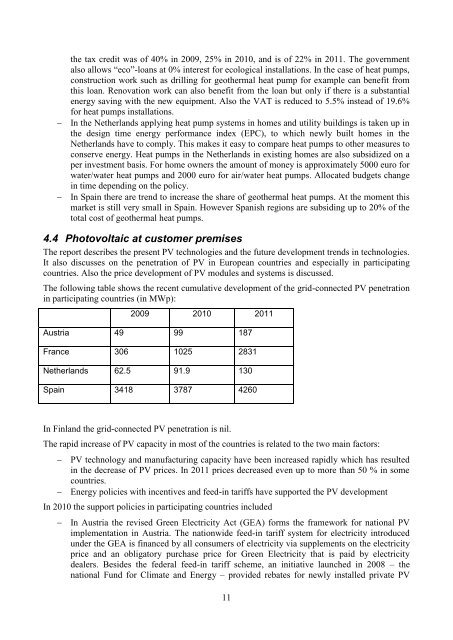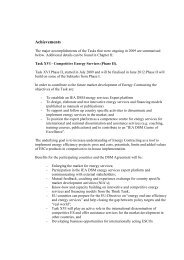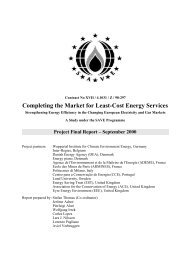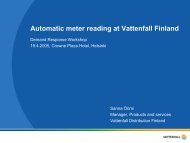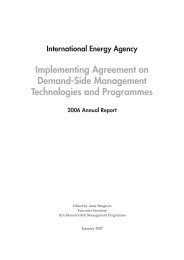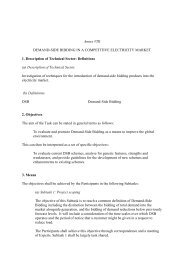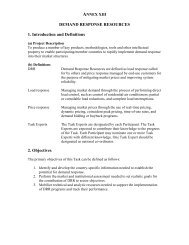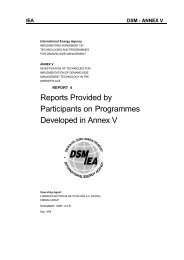the tax credit was of 40% in 2009, 25% in 2010, <strong>and</strong> is of 22% in 2011. The governmentalso allows “eco”-loans at 0% interest for ecological installations. In the case of heat pumps,construction work such as drilling for geothermal heat pump for example can benefit fromthis loan. Renovation work can also benefit from the loan but only if there is a substantialenergy saving with the new equipment. Also the VAT is reduced to 5.5% instead of 19.6%for heat pumps installations. In the Netherl<strong>and</strong>s applying heat pump systems in homes <strong>and</strong> utility buildings is taken up inthe design time energy performance index (EPC), to which newly built homes in theNetherl<strong>and</strong>s have to comply. This makes it easy to compare heat pumps to other measures toconserve energy. Heat pumps in the Netherl<strong>and</strong>s in existing homes are also subsidized on aper investment basis. For home owners the amount of money is approximately 5000 euro forwater/water heat pumps <strong>and</strong> 2000 euro for air/water heat pumps. Allocated budgets changein time depending on the policy. In Spain there are trend to increase the share of geothermal heat pumps. At the moment thismarket is still very small in Spain. However Spanish regions are subsiding up to 20% of thetotal cost of geothermal heat pumps.4.4 Photovoltaic at customer premisesThe report describes the present PV technologies <strong>and</strong> the future development trends in technologies.It also discusses on the penetration of PV in European countries <strong>and</strong> especially in participatingcountries. Also the price development of PV modules <strong>and</strong> systems is discussed.The following table shows the recent cumulative development of the grid-connected PV penetrationin participating countries (in MWp):2009 2010 2011Austria 49 99 187France 306 1025 2831Netherl<strong>and</strong>s 62.5 91.9 130Spain 3418 3787 4260In Finl<strong>and</strong> the grid-connected PV penetration is nil.The rapid increase of PV capacity in most of the countries is related to the two main factors: PV technology <strong>and</strong> manufacturing capacity have been increased rapidly which has resultedin the decrease of PV prices. In 2011 prices decreased even up to more than 50 % in somecountries. Energy policies with incentives <strong>and</strong> feed-in tariffs have supported the PV developmentIn 2010 the support policies in participating countries included In Austria the revised Green Electricity Act (GEA) forms the framework for national PVimplementation in Austria. The nationwide feed-in tariff system for electricity introducedunder the GEA is financed by all consumers of electricity via supplements on the electricityprice <strong>and</strong> an obligatory purchase price for Green Electricity that is paid by electricitydealers. Besides the federal feed-in tariff scheme, an initiative launched in 2008 – thenational Fund for Climate <strong>and</strong> Energy – provided rebates for newly installed private PV11
systems up to 5 kW installed capacity. In 2010 17,8 million EUR were granted under thisfunding scheme, leading to an installed capacity of over 11 MW. Each Austrian province isalso running regional PV rebate programs, aimed at overcoming the limitations of federalincentives. In most cases the support is subject to limited budgets <strong>and</strong> is linked to furtherrequirements. Generally, the regional support is only granted where the installation is notsupported by the federal feed-in tariff scheme. In 2010 the regional funding initiativesamounted to about 39,6 million EUR <strong>and</strong> helped to install a total PV capacity of about 22,6MW. In France public initiatives structured <strong>and</strong> supported the expansion of the PV market during2010: these included the feed-in tariff with a highly specific orientation towards buildingintegration, the income tax credit of 25 % of the amount of the investment in PV systemgoods (this was 50 % until 29 September 2010) up to a cap of 8 000 EUR per taxpayer (16000 EUR for a couple), the ADEME-FACE contracts for off-grid systems <strong>and</strong> variousregional <strong>and</strong> local government support measures. In order to control the development of themarket the French government set up in 2011 a new method of evolution of the purchaseobligation prices. Since March 10th, 2011, the prices of the purchase obligation arereviewed every trimester (July 1st, 2011, October 1st, 2011, January 1st, 2012, etc). Theseprices depend on the number of installations dem<strong>and</strong>ed. In the Netherl<strong>and</strong>s the market increase in 2010 compared to previous years is partly due tothe release of a backlog of grants following the start of the new subsidy scheme (SDE) in2008. Grants from previous years still remain in the pipeline. The subsidy scheme has nowbeen revised <strong>and</strong> systems below 15 kW are no longer supported. In Spain Royal Decree 1565/2010 has amended the economic regime contained in RoyalDecree 1578/2008 for photovoltaic installations in operation, putting electricity into the grid<strong>and</strong> registered in the Administrative Registry of Producers after 30 September 2008. Feed-intariffs have been amended as follows: 45 % reduction for ground-based PV installations,25 % reduction for large rooftop installations (> 20 kW), <strong>and</strong> 5 % reduction for smaller rooftopsystems. With regard to PV systems in operation, putting electricity into the grid <strong>and</strong>registered before 30 September 2008, their economic regime has also been amended bycancelling the feed-in tariff after 25 years of operation. Other amendments include adefinition of a ‹substantial change› in installations whereby the plant may become ineligibleto continue to receive the feed-in tariff set in the previous economic regime. The feed-intariff paid to Spanish PV installations was also reduced through limiting the operationalhours, via Royal Decree Law 14/2010. Operational hours are limited to 1250 hours per yearfor fixed systems, 1644 hours per year for single-axis tracking systems <strong>and</strong> 1707 hours peryear for two-axis tracking systems. Surplus generation outside these hours is purchased atregular wholesale electricity market prices. The limitation applies for the next three years;however, to compensate, the total period for which the feed-in tariff can be obtained hasbeen extended three years. In addition, a network toll has been introduced, applicable to allelectricity generation plants, with PV plants being exempt for the first three years.4.5 Smart meteringThe report analyzes the technologies, regulation, costs <strong>and</strong> benefits as well as experiences of smartmetering. It also describes the current situation of smart metering in the participating countries.Short summary of this is as follows.4.5.1 AustriaAccording to the new Electricity Act (ElWOG 2010), the Minister of Economy may introducesmart metering per decree, following a cost-benefit-analysis. The regulator may define12


